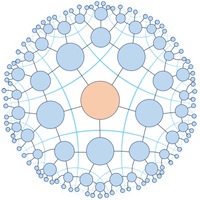Quantum Lego Expansion Pack: Enumerators from Tensor Networks
引用次数: 0
Abstract
We provide the first tensor-network method for computing quantum weight enumerator polynomials in the most general form. If a quantum code has a known tensor-network construction of its encoding map, our method is far more efficient, and in some cases exponentially faster than the existing approach. As a corollary, it produces decoders and an algorithm that computes the code distance. For non-(Pauli)-stabilizer codes, this constitutes the current best algorithm for computing the code distance. For degenerate stabilizer codes, it can be substantially faster compared to the current methods. We also introduce novel weight enumerators and their applications. In particular, we show that these enumerators can be used to compute logical error rates exactly and thus construct (optimal) decoders for any independent and identically distributed single qubit or qudit error channels. The enumerators also provide a more efficient method for computing nonstabilizerness in quantum many-body states. As the power for these speedups rely on a quantum Lego decomposition of quantum codes, we further provide systematic methods for decomposing quantum codes and graph states into a modular construction for which our technique applies. As a proof of principle, we perform exact analyses of the deformed surface codes, the holographic pentagon code, and the two-dimensional Bacon-Shor code under (biased) Pauli noise and limited instances of coherent error at sizes that are inaccessible by brute force.

量子乐高扩展包:张量网络枚举器
我们提供了第一种以最一般形式计算量子权重枚举多项式的张量网络方法。如果量子密码的编码图具有已知的张量网络结构,我们的方法就会更有效,在某些情况下甚至比现有方法快数倍。作为推论,它还能产生解码器和计算编码距离的算法。对于非(保利)稳定器码,这是目前计算码距的最佳算法。对于退化稳定器码,它比现有方法快得多。我们还介绍了新型权值枚举器及其应用。我们特别展示了这些枚举器可用于精确计算逻辑错误率,从而为任何独立且同分布的单阙比特或阙比特错误信道构建(最优)解码器。枚举器还为计算量子多体态的不稳定性提供了一种更有效的方法。由于这些提速的动力依赖于量子密码的量子乐高分解,我们进一步提供了将量子密码和图状态分解为模块结构的系统方法,我们的技术适用于这种模块结构。作为原理证明,我们对变形表面代码、全息五边形代码和二维 Bacon-Shor 代码在(偏)保利噪声和有限的相干误差情况下进行了精确分析,而这些误差的大小是蛮力无法达到的。
本文章由计算机程序翻译,如有差异,请以英文原文为准。
求助全文
约1分钟内获得全文
求助全文

 求助内容:
求助内容: 应助结果提醒方式:
应助结果提醒方式:


